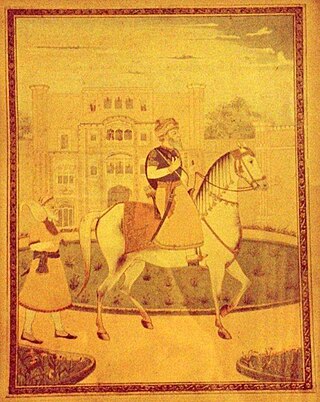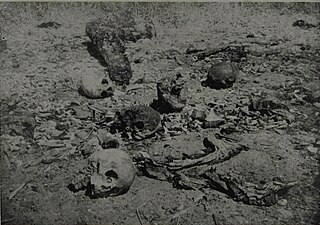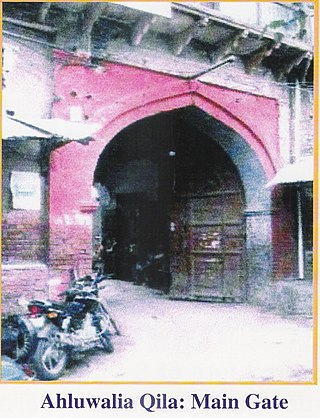Guru Nanak founded the Sikh religion in the Punjab region of the northern part of the Indian subcontinent in the 15th century and opposed many traditional practices like fasting, janeu, idolatry, caste system, ascetism, azan, economic materialism, and gender discrimination.

Jassa Singh Ramgarhia (1723–1803) was a prominent Sikh leader during the period of the Sikh Confederacy. He was the founder of the Ramgarhia Misl.

Sultan-ul-Qaum Sardar Jassa Singh Ahluwalia was a Sikh leader during the period of the Sikh Confederacy, being the Supreme Leader of the Dal Khalsa. He was also Misldar of the Ahluwalia Misl. This period was an interlude, lasting roughly from the time of the death of Banda Bahadur in 1716 to the founding of the Sikh Empire in 1801. He founded the Kapurthala State in 1772.

Baghel Singh was a Military general in the Punjab region in the northern part of the Indian subcontinent in the 18th century. He rose to prominence in the area around Sutlej and Yamuna. Singh joined the Singh Krora Misl, one of the misls during Sikh Confederacy. In 1765, Singh became the leader of the misl.
Khushal Singh Virk was the second chief of Singhpuria Misl from 1753 to 1795, extending its territory on both sides of the Sutlej River. His 'acquired' lands included Jalandhar, Nurpur, Bahrampur, Patti and Bharatgarh. Jalandhar doab and adjoining areas yielded an annual income of three lakh rupees.

Vadda Ghalughara was the mass murder of unarmed Sikhs by the Afghan forces of the Durrani Empire during the years of Afghan influence in the Punjab region of the Indian subcontinent owing to the repeated incursions of Ahmad Shah Durrani in February 1762. It is distinguished from the Chhota Ghalughara. Mostly non-combatants were killed in the event, and an estimated that 10,000 to 50,000 Sikhs were killed on 5 February 1762.

The Kalwar,KalalorKalar are an Indian caste historically found in Uttar Pradesh, Rajasthan, Punjab, Haryana, Jammu & Kashmir and other parts of north and central India. The caste is traditionally associated with the distillation and selling of liquor, but around the start of the 20th century assorted Kalwar caste organisations sought to leave that trade and redefine their community through Sanskritisation process.
The Battle of Sialkot took place on 12 November 1763, between the Durrani Empire, led by Jahan Khan, and the Sukerchakia Misl, led by Charat Singh, as part of the Afghan-Sikh wars which concluded with Sikh victory.
Ahmad Shah Durrani raided India for the fifth time in 1759, initiating a series of conflicts with the Marathas and Sikhs. The Pashtuns, preparing for armed struggle, quickly advanced into Punjab, capturing a Maratha garrison at Peshawar and later overrunning Attock. General Jahan Khan played a key role in the advance but was met with resistance from the Marathas and their Sikh allies, led by Sabaji Shinde and the armies of the Sukerchakia and Ahluwalia Misls. In a fierce battle, the combined forces of the Marathas and Sikhs defeated the Afghans, killing 2,000 and wounding Jahan Khan. Despite being outnumbered, Sabaji managed to defend Lahore and inflicted a severe defeat on Jahan Khan, who retreated to Peshawar. This defeat angered Ahmad Shah Durrani and prompted him to take action.

Ramgarhia Misl was a sovereign state (misl) in the Sikh Confederacy of Punjab region in present-day India and Pakistan. The misl's name is derived from Qila Ramgarh, a place located in Ramsar, near Amritsar, which was fortified and redesigned by Ramgarhia Misl chief Jassa Singh Ramgarhia. The Ramgarhia Misl was one of the twelve major Sikh misls, and held land near Amritsar.

The Battle of Delhi was fought between Khalsa Sikhs and the Mughal Empire in 1783.
Sardar Chuhar Singh of Jharauli was a general of Shaheedan Misl. He was the paternal cousin of Rai Singh Bhangi and close relative of Sikh warrior Baba Deep Singh. Under the command of Jassa Singh Ahluwalia, he fought for Shaheedan Misl in the Battle of Sirhind (1764) against Mughal Faujdar of Sirhind, Zain Khan Sirhindi. He secured Jharauli, Fatehgarh Atri, Ajrana and seven other villages by Markanda River. He had two sons, Karam Singh and Mohar Singh. The younger Mohar Singh took charge of the Jharauli estate. His elder son Karam Singh took control of the family estate at Chung that was finally incorporated to Lahore Darbar by issueless Ranjit Singh after his death in 1808. Mohar Singh lost seven villages of the Jharauli estate to Bhunga Singh of Thanesar in 1780. The Jharauli estate remained under the Court of Wards during 1885-1893 and again between 1922-1947.

Ahluwalia was a misl, that is, a sovereign state in the Sikh Confederacy of Punjab region in present-day India and Pakistan. The misl's name is derived from Ahlu, the ancestral village of the misl leaders. The Ahluwalia misl was one of the 12 major Sikh misls, and held land to the north of Sutlej river.
The siege of Patiala was a 7-day siege fought between the Sikh forces led by Raja Amar Singh and Mughal forces led by Abdul Ahad Khan.
The Battle of Anandpur, also known as the Battle of Makhowal was fought on 5 March 1753 by the Sikh forces led by Jassa Singh Ahluwalia and Mughal forces led by Adina Beg. Large losses were sustained by the Sikh forces.
The Battle of Sodhra and Badra was fought in the second week of March 1748 by the Sikh forces led by Jassa Singh Ahluwalia and the Mughal forces led by Raja Gurdit Mal.
The Battle of Chamkaur was fought in January 1764 by Sikh forces led by Jassa Singh Ahluwalia and Afghan forces led by Lachhmi Narain.
The Battle of Nadaun was fought in August 1752 by the Mandi and Guler state led by the Rajas of the states and the Mughal Empire led by Aziz Khan, the steward of Mir Mannu. The Hill States were supported by the Sikhs led by Jassa Singh Ahluwalia.
The Second Battle of Lahore was fought in November 1759 by the Sikh forces led by Jassa Singh Ahluwalia and the Afghan forces led by Jahan Khan.
The Battle of Talwara was fought in 1770 by the Sikh forces led by Jassa Singh Ramgarhia and the Kangra forces led by Raja Ghamand Chand.







